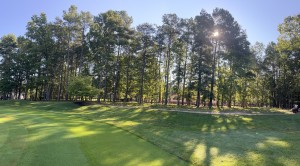We have talked at length about the troubles that trees cause for concrete. Thankfully we’ve addressed many of those issues in the past 3 years. We have not talked so much about the trouble they cause for grass and more specifically, greens and tees. Extreme summer weather has moved out and shade is becoming our biggest enemy. As we move into fall there is less sunlight each day and what sun we do get is lower in the sky. The course is nearly 30 years old and the trees have matured a great deal in that time. Shade this time of year greatly affects the turf’s ability to recover from the stresses of summer. We can’t do much about the weather, but we can remove trees to increase the amount of sunlight that grass receives. If you have a few minutes, please read the two articles below from USGA. If you just want the highlights, scroll past the links for a summary. We need to give serious thought to removing trees that are causing trouble.

Pines are the biggest Challenge
Throwing Shade
- Just because late-season shade isn’t experienced during the summer doesn’t mean it’s any less harmful. In fact, it could be more harmful if the shade comes in late August or September as cool-season grasses are recovering from a long, difficult summer. Shade at this time of the year means that grass cannot fully recover before winter, enters spring weak, and might not have enough time to fully recover before summer. This is a spiral that can only be broken if sunlight is improved in the fall and/or winter.
- It is important that growing environments, and shade in particular, are assessed at all times of the year – not only in summer when the course is most active. If you take an objective look, you might be surprised how much weak grass during the season is connected to fall and winter shade, not summer shade.
 Light The Way…
Light The Way…
- Turf growth of short grass is limited in the shade because shorter turf has minimal leaf area to intercept sunlight in the first place, which is why divots are so slow to recover on a heavily shaded tee. It should come as no surprise that putting greens suffer the most from shade since they possess little more than a thin veneer of leaf tissue mowed once or more each day at, or below, 0.125-inch.
- Turf health and playability go hand in hand because superintendents manipulate the turf to provide a desired playing surface. Golfers then play on that surface, causing wear that everyone hopes will recover quickly; except sometimes turf doesn’t recover quickly. Obviously, the inability to rapidly recover from wear would affect the popular, heavily played golf facilities the most, but all courses are affected by wear issues and the loss of turf cover from time to time. Heavy play, disease activity, excessive heat, mechanical wear, and the stress associated with too much or too little water are factors that necessitate rapid turf recovery – but rapid turf recovery is impossible in the shade.
- Shaded turf that is weak entering winter has little chance to make and store the carbohydrates needed for rapid spring greenup. Any winter injury will also be extra slow to recover due to carbohydrate depletion. Spring growth and winter injury recovery is also limited by low soil temperatures that persist longer in shaded sites.
- Most greens that have severe tree shade issues will also have problems associated with poor air circulation and tree roots competing with turf for water and nutrients. The lack of air circulation can be especially detrimental to turf health during extended periods of hot, humid weather.
- A thin, shaded putting surface will have a greater chance of developing moss encroachment problems than dense turf in full sun.
- Recovery from cultural practices that thin out the stand of turf – such as aeration and deep vertical mowing – occurs more slowly on shaded turf than turf in full sun.


